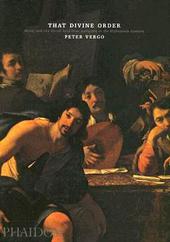
|
That Divine Order: Music and the Visual Arts from Antiquity to the Eighteenth Century
Hardback
Main Details
| Title |
That Divine Order: Music and the Visual Arts from Antiquity to the Eighteenth Century
|
| Authors and Contributors |
By (author) Peter Vergo
|
|
Edited by Beulah Davies
|
|
Designed by Karl Shanahan
|
| Physical Properties |
| Format:Hardback | | Pages:304 | | Dimensions(mm): Height 245,Width 172 |
|
| Category/Genre | The arts - general issues
Theory of music and musicology |
|---|
| ISBN/Barcode |
9780714843513
|
| Classifications | Dewey:780.1 |
|---|
| Audience | |
|---|
|
Publishing Details |
| Publisher |
Phaidon Press Ltd
|
| Imprint |
Phaidon Press Ltd
|
| Publication Date |
25 July 2005 |
| Publication Country |
United Kingdom
|
Description
Ever since antiquity, philosophers have pointed to the supposed 'divine' character of music, and following Pythagoras's discovery of the mathematical basis of the musical scale, have posited a link between the mathematical order of music, the physical order of the universe and the moral order of human society. Both practising artists and moralists came to believe that, by demonstrating an analogy with music, they could claim a dignity and value for their art - whether painting, architecture or sculpture - that it might otherwise lack. Why was this so? What was the point of such analogies? What advantages was music believed to enjoy, by comparison with the visual arts? Artists and critics frequently cited music as a manifestation of God-given order to which visual arts should aspire. But on what evidence was this belief in the inherently systematic character of music based; and in practical terms, how might visual art seek to emulate any such divine order or system? In what way might Gothic cathedrals have been based on systems of harmonic proportion? How did Poussin's search for a compositional principle derived from antique 'modes' in music resemble, or differ from, Palladio's attempts to embody musical 'harmonies' in architecture? And how did each artist conceive of the sense and value of such analogies? Systematic answers to such questions have hitherto been lacking, and, for the first time, Professor Vergo makes direct and detailed comparisons between musical and pictorial practices in the long period covered by the book. He also provides a broad analysis of changes in the character of the analogies drawn at different times, using in his analyses critical and philosophical sources as well as evidence about artistic and musical practice. That Divine Order will be of interest to art historians and musicologists, to practising artists and musicians, to students of cultural history and those concerned with aesthetic theory and interdisciplinary studies.
Author Biography
Peter Vergo is Professor of Art History and Theory at the University of Essex, a widely respected art historian and author of several books on art and music studies including the classic Art in Vienna 1898-1918, published by Phaidon
Reviews"This is a fine book for students of art and music, which has been thoroughly researched and cogently written. It is also liberally illustrated with monochrome figures and a number of coulour plates."-Musical Opinions "Over a long period, Peter Vergo has submitted music and the visual arts to sustained comparative analysis. Often on untrodden ground, for a time the only voice in British scholarship in this field, his work is consistently engaging and enlightening... Vergo teases logical sequences from dense histories - for instance the trajectory of Chopin-Delacroix-Baudelaire-Whistler-Debussy... The range and scope of the two volumes That Divine Order and The Music of Painting is astonishing... Together, these two volumes offer a dictionary of the subject that will be invaluable to scholarship for years to come. This latest study not only makes it clear once and for all the significance of the interchange of the arts, but, I would suggest, casts new light on Modernism itself."-The Burlington Magazine
|